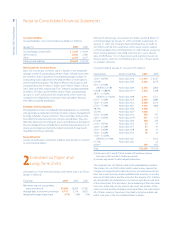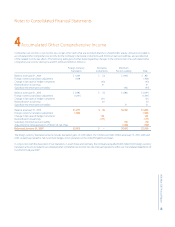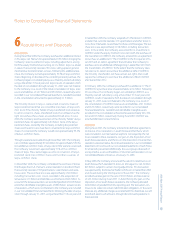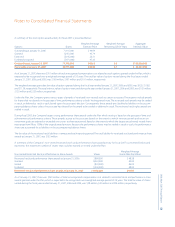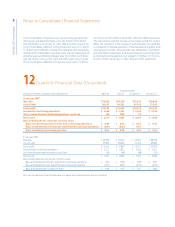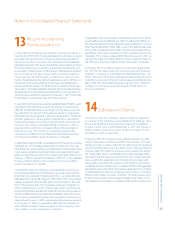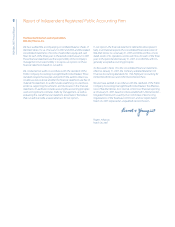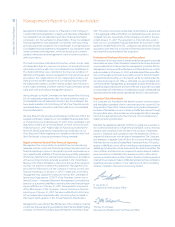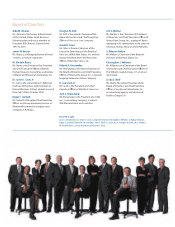Walmart 2007 Annual Report Download - page 57
Download and view the complete annual report
Please find page 57 of the 2007 Walmart annual report below. You can navigate through the pages in the report by either clicking on the pages listed below, or by using the keyword search tool below to find specific information within the annual report.
Wal-Mart 2007 Annual Report 55
The Company believes that the district court’s ruling is incorrect. On
August 31, 2004, the United States Court of Appeals for the Ninth Circuit
granted the Company’s petition for discretionary review of the ruling.
On February 6, 2007, a divided three-judge panel of the United States
Court of Appeals for the Ninth Circuit issued a decision a rming the
district court’s certi cation order. On February 20, 2007, the Company
led a petition asking that the decision be reconsidered by a larger
panel of the court. If the Company is not successful in its appeal of
class certi cation, or an appellate court issues a ruling that allows for
the certi cation of a class or classes with a di erent size or scope, and
if there is a subsequent adverse verdict on the merits from which there
is no successful appeal, or in the event of a negotiated settlement of
the litigation, the resulting liability could be material to the Company.
The plainti s also seek punitive damages which, if awarded, could
result in the payment of additional amounts material to the Company.
However, because of the uncertainty of the outcome of the appeal from
the district court’s certi cation decision, because of the uncertainty of
the balance of the proceedings contemplated by the district court,
and because the Company’s liability, if any, arising from the litigation,
including the size of any damages award if plainti s are successful in
the litigation or any negotiated settlement, could vary widely, the
Company cannot reasonably estimate the possible loss or range of
loss which may arise from the litigation.
Until recently, the Company was a defendant in Mauldin v. Wal-Mart
Stores, Inc., a class-action lawsuit that was led on October 16, 2001, in
the United States District Court for the Northern District of Georgia,
Atlanta Division. A class was certi ed on August 23, 2002, consisting
of female Wal-Mart associates who were participants in the Associates
Health and Welfare Plan at any time from March 8, 2001, to the pres-
ent and who were using prescription contraceptives. The class sought
amendment of the Plan to include coverage for prescription contra-
ceptives, back pay for all members in the form of reimbursement of
the cost of prescription contraceptives, prejudgment interest and
attorneys’ fees. On December 8, 2006, the plainti s led an unopposed
motion to dismiss the case voluntarily in light of the Company’s
recent amendment of the Plan to provide such coverage beginning
January 1, 2007. On December 20, the Court entered an order grant-
ing the motion and dismissing the case.
The Company is a defendant in a lawsuit that was led on August 24,
2001, in the U.S. District Court for the Eastern District of Kentucky.
EEOC (Janice Smith) v. Wal-Mart Stores, Inc. is an action brought by the
EEOC on behalf of Janice Smith and all other females who made
application or transfer requests at the London, Kentucky, distribution
center from 1995 to the present, and who were not hired or transferred
into the warehouse positions for which they applied. The class seeks
back pay for those females not selected for hire or transfer during the
relevant time period. The class also seeks injunctive and prospective
a rmative relief. The complaint alleges that the Company based hir-
ing decisions on gender in violation of Title VII of the 1964 Civil Rights
Act as amended. The EEOC can maintain this action as a class without
certi cation. The Company cannot reasonably estimate the possible
loss or range of loss which may arise from this litigation.
On November 8, 2005, the Company received a grand jury subpoena
from the U.S. Attorney’s O ce for the Central District of California,
seeking documents and information relating to the Company’s receipt,
transportation, handling, identi cation, recycling, treatment, storage
and disposal of certain merchandise that constitutes hazardous
materials or hazardous waste. The Company has been informed by
the U.S. Attorney’s O ce for the Central District of California that it is
a target of a criminal investigation into potential violations of the
Resource Conservation and Recovery Act (“RCRA”), the Clean Water
Act, and the Hazardous Materials Transportation Statute. This U.S.
Attorney’s O ce contends, among other things, that the use of
Company trucks to transport certain returned merchandise from the
Company’s stores to its return centers is prohibited by RCRA because
those materials may be considered hazardous waste. The government
alleges that, to comply with RCRA, the Company must ship from the
store certain materials as “hazardous waste” directly to a certi ed dis-
posal facility using a certi ed hazardous waste carrier. The Company
contends that the practice of transporting returned merchandise to
its return centers for subsequent disposition, including disposal by
certi ed facilities, is compliant with applicable laws and regulations.
The Company cannot reasonably estimate the possible loss or range
of loss which may arise from this matter.
Additionally, the U.S. Attorney’s Office in the Northern District of
California has initiated its own investigation regarding the Company’s
handling of hazardous materials and hazardous waste and the Company
has received administrative document requests from the California
Department of Toxic Substances Control requesting documents and
information with respect to two of the Company’s distribution facilities.
Further, the Company also received a subpoena from the Los Angeles
County District Attorney’s O ce for documents and administrative
interrogatories requesting information, among other things, regarding
the Company’s handling of materials and hazardous waste. California
state and local government authorities and the State of Nevada have
also initiated investigations into these matters. The Company is
cooperating fully with the respective authorities. The Company
cannot reasonably estimate the possible loss or range of loss
which may arise from this matter.
Notes to Consolidated Financial Statements



